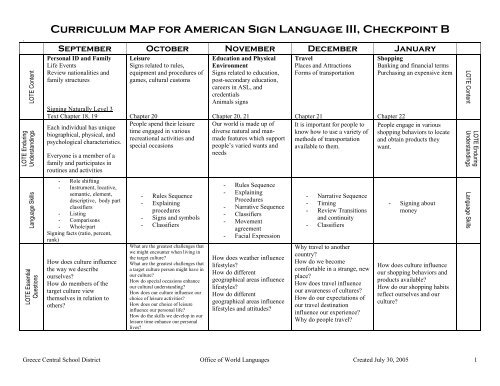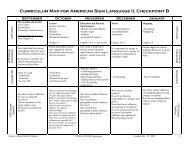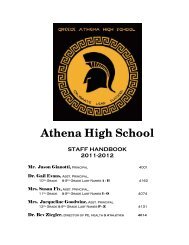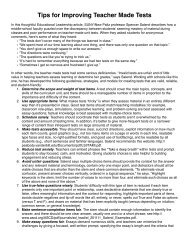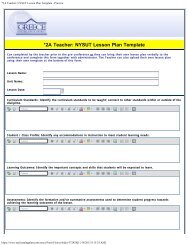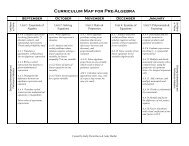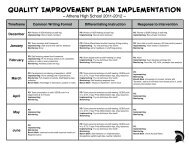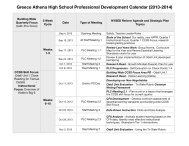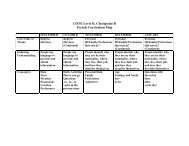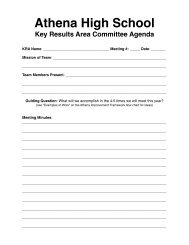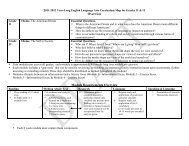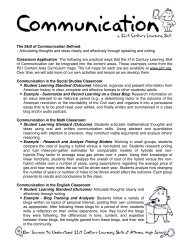Curriculum Map (ASL 3)
Curriculum Map (ASL 3)
Curriculum Map (ASL 3)
Create successful ePaper yourself
Turn your PDF publications into a flip-book with our unique Google optimized e-Paper software.
.<br />
LOTE Content<br />
LOTE Enduring<br />
Understandings<br />
Language Skills<br />
LOTE Essential<br />
Questions<br />
<strong>Curriculum</strong> <strong>Map</strong> for American Sign Language III, Checkpoint B<br />
September October November December January<br />
Personal ID and Family<br />
Life Events<br />
Review nationalities and<br />
family structures<br />
Signing Naturally Level 3<br />
Text Chapter 18, 19<br />
Each individual has unique<br />
biographical, physical, and<br />
psychological characteristics.<br />
Everyone is a member of a<br />
family and participates in<br />
routines and activities<br />
- Role shifting<br />
- Instrument, locative,<br />
semantic, element,<br />
descriptive, body part<br />
classifiers<br />
- Listing<br />
- Comparisons<br />
- Whole/part<br />
Signing facts (ratio, percent,<br />
rank)<br />
How does culture influence<br />
the way we describe<br />
ourselves<br />
How do members of the<br />
target culture view<br />
themselves in relation to<br />
others<br />
Leisure<br />
Signs related to rules,<br />
equipment and procedures of<br />
games, cultural customs<br />
Chapter 20<br />
People spend their leisure<br />
time engaged in various<br />
recreational activities and<br />
special occasions<br />
- Rules Sequence<br />
- Explaining<br />
procedures<br />
- Signs and symbols<br />
- Classifiers<br />
What are the greatest challenges that<br />
we might encounter when living in<br />
the target culture<br />
What are the greatest challenges that<br />
a target culture person might have in<br />
our culture<br />
How do special occasions enhance<br />
our cultural understanding<br />
How does our culture influence our<br />
choice of leisure activities<br />
How does our choice of leisure<br />
influence our personal life<br />
How do the skills we develop in our<br />
leisure time enhance our personal<br />
lives<br />
Education and Physical<br />
Environment<br />
Signs related to education,<br />
post-secondary education,<br />
careers in <strong>ASL</strong>, and<br />
credentials<br />
Animals signs<br />
Chapter 20, 21<br />
Our world is made up of<br />
diverse natural and manmade<br />
features which support<br />
people’s varied wants and<br />
needs<br />
- Rules Sequence<br />
- Explaining<br />
Procedures<br />
- Narrative Sequence<br />
- Classifiers<br />
- Movement<br />
agreement<br />
- Facial Expression<br />
How does weather influence<br />
lifestyles<br />
How do different<br />
geographical areas influence<br />
lifestyles<br />
How do different<br />
geographical areas influence<br />
lifestyles and attitudes<br />
Travel<br />
Places and Attractions<br />
Forms of transportation<br />
Chapter 21<br />
It is important for people to<br />
know how to use a variety of<br />
methods of transportation<br />
available to them.<br />
- Narrative Sequence<br />
- Timing<br />
- Review Transitions<br />
and continuity<br />
- Classifiers<br />
Why travel to another<br />
country<br />
How do we become<br />
comfortable in a strange, new<br />
place<br />
How does travel influence<br />
our awareness of cultures<br />
How do our expectations of<br />
our travel destination<br />
influence our experience<br />
Why do people travel<br />
Shopping<br />
Banking and financial terms<br />
Purchasing an expensive item<br />
Chapter 22<br />
People engage in various<br />
shopping behaviors to locate<br />
and obtain products they<br />
want.<br />
- Signing about<br />
money<br />
How does culture influence<br />
our shopping behaviors and<br />
products available<br />
How do our shopping habits<br />
reflect ourselves and our<br />
culture<br />
LOTE Content<br />
LOTE Enduring<br />
Understandings<br />
Language Skills<br />
Greece Central School District Office of World Languages Created July 30, 2005 1
<strong>Curriculum</strong> <strong>Map</strong> for American Sign Language III, Checkpoint B<br />
LOTE Content<br />
Enduring<br />
Understandi<br />
ngs<br />
Language Skills<br />
LOTE Essential<br />
Questions<br />
February March April May June<br />
Community and<br />
Neighborhood<br />
Incidents, things that happen<br />
in the community<br />
Signing Naturally 3 text<br />
Chapter 21<br />
Everyone is a member of a<br />
community that provides<br />
opportunities for work,<br />
leisure, and social interaction<br />
- Narrative Sequence<br />
- Classifiers<br />
- Sentence Types<br />
How is our life different if we<br />
are raised in the city, suburb,<br />
a village, or the country<br />
How is our life different if we<br />
are raised in a house, an<br />
apartment, a condo, etc.<br />
How is our community<br />
experienced differently by<br />
various groups or cultures<br />
How do target language<br />
cultures perceive our culture<br />
House and Home<br />
Earning a Living<br />
Items in a house, types of<br />
dwellings<br />
Job responsibilities<br />
and requirements, feelings<br />
about work<br />
Decision making<br />
Chapter 23<br />
There are various types of<br />
lodging which contain the<br />
items that are essential for<br />
comfortable living.<br />
- Locative, descriptive<br />
classifiers<br />
- Plural<br />
- Describing<br />
arrangement of a<br />
room<br />
- Maintaining<br />
conversation<br />
- Clarifying<br />
How does our home<br />
environment reflect our<br />
culture<br />
How does culture influence<br />
our home environment<br />
Meal Taking<br />
Flavors, meal preparation,<br />
food signs<br />
Taste/texture<br />
No text<br />
People eat for nutrition and<br />
for opportunities for social<br />
interaction<br />
- Classifiers<br />
- Describing objects<br />
- Listing<br />
What is the role of food in<br />
the target culture<br />
How does the geography of<br />
the country have an impact<br />
on the food<br />
How is food a reflection of<br />
culture<br />
Public and Private Services<br />
Health and Welfare<br />
Community and travel vocab<br />
Symptoms, injuries,<br />
remedies, disease, treatment<br />
Chapter 24<br />
It is important to identify and<br />
understand parts of the<br />
human body to maintain<br />
optimum health.<br />
- Dialogue<br />
- Role Shift<br />
- Interpreter’s Role<br />
- Classifiers<br />
- Rhetorical Question<br />
- Dealing with<br />
terminology (no<br />
sign)<br />
- Coherent<br />
presentations<br />
What is health and wellness<br />
How does culture influence<br />
our view of our body (the<br />
way we treat it, care for it,<br />
look at it, etc.)<br />
How does the level of health<br />
care have an impact on the<br />
general well-being of the<br />
culture<br />
Exam Review and Speaking<br />
Tasks<br />
LOTE Content<br />
Enduring<br />
Understandi<br />
ngs<br />
Language Skills<br />
LOTE Essential<br />
Questions<br />
Greece Central School District Office of World Languages Created July 30, 2005 2


